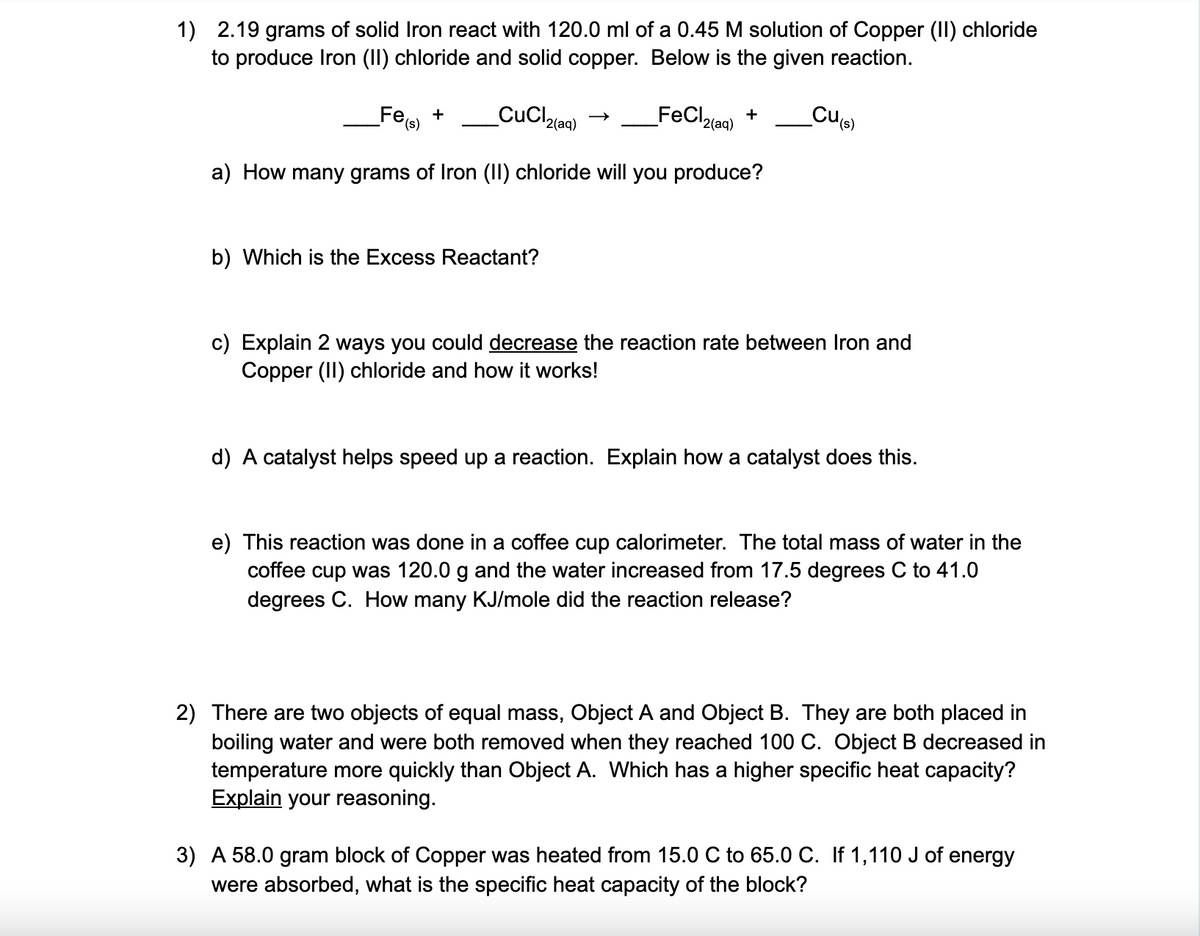) 2.19 grams of solid Iron react with 120.0 ml of a 0.45 M solution of Copper (II) chloride to produce Iron (II) chloride and solid copper. Below is the given reaction. Fe + _CuCl(aq) FeCltac) + a) How many grams of Iron (II) chloride will you produce? b) Which is the Excess Reactant? c) Explain 2 ways you could decrease the reaction rate between Iron and Copper (II) chloride and how it works! d) A catalyst helps speed up a reaction. Explain how a catalyst does this.
) 2.19 grams of solid Iron react with 120.0 ml of a 0.45 M solution of Copper (II) chloride to produce Iron (II) chloride and solid copper. Below is the given reaction. Fe + _CuCl(aq) FeCltac) + a) How many grams of Iron (II) chloride will you produce? b) Which is the Excess Reactant? c) Explain 2 ways you could decrease the reaction rate between Iron and Copper (II) chloride and how it works! d) A catalyst helps speed up a reaction. Explain how a catalyst does this.
Principles of Modern Chemistry
8th Edition
ISBN:9781305079113
Author:David W. Oxtoby, H. Pat Gillis, Laurie J. Butler
Publisher:David W. Oxtoby, H. Pat Gillis, Laurie J. Butler
Chapter15: Acid–base Equilibria
Section: Chapter Questions
Problem 98AP
Related questions
Question

Transcribed Image Text:1) 2.19 grams of solid Iron react with 120.0 ml of a 0.45 M solution of Copper (II) chloride
to produce Iron (II) chloride and solid copper. Below is the given reaction.
Fee +
CuCl,
FeCl,
+
'2(aq)
Culs)
(s),
'2(aq)
a) How many grams of Iron (II) chloride will you produce?
b) Which is the Excess Reactant?
c) Explain 2 ways you could decrease the reaction rate between Iron and
Copper (II) chloride and how it works!
d) A catalyst helps speed up a reaction. Explain how a catalyst does this.
e) This reaction was done in a coffee cup calorimeter. The total mass of water in the
coffee cup was 120.0 g and the water increased from 17.5 degrees C to 41.0
degrees C. How many KJ/mole did the reaction release?
2) There are two objects of equal mass, Object A and Object B. They are both placed in
boiling water and were both removed when they reached 100 C. Object B decreased in
temperature more quickly than Object A. Which has a higher specific heat capacity?
Explain your reasoning.
3) A 58.0 gram block of Copper was heated from 15.0 C to 65.0 C. If 1,110 J of energy
were absorbed, what is the specific heat capacity of the block?
Expert Solution
This question has been solved!
Explore an expertly crafted, step-by-step solution for a thorough understanding of key concepts.
Step by step
Solved in 2 steps with 1 images

Knowledge Booster
Learn more about
Need a deep-dive on the concept behind this application? Look no further. Learn more about this topic, chemistry and related others by exploring similar questions and additional content below.Recommended textbooks for you

Principles of Modern Chemistry
Chemistry
ISBN:
9781305079113
Author:
David W. Oxtoby, H. Pat Gillis, Laurie J. Butler
Publisher:
Cengage Learning

Chemistry: The Molecular Science
Chemistry
ISBN:
9781285199047
Author:
John W. Moore, Conrad L. Stanitski
Publisher:
Cengage Learning

Chemistry for Engineering Students
Chemistry
ISBN:
9781337398909
Author:
Lawrence S. Brown, Tom Holme
Publisher:
Cengage Learning

Principles of Modern Chemistry
Chemistry
ISBN:
9781305079113
Author:
David W. Oxtoby, H. Pat Gillis, Laurie J. Butler
Publisher:
Cengage Learning

Chemistry: The Molecular Science
Chemistry
ISBN:
9781285199047
Author:
John W. Moore, Conrad L. Stanitski
Publisher:
Cengage Learning

Chemistry for Engineering Students
Chemistry
ISBN:
9781337398909
Author:
Lawrence S. Brown, Tom Holme
Publisher:
Cengage Learning

Chemistry & Chemical Reactivity
Chemistry
ISBN:
9781337399074
Author:
John C. Kotz, Paul M. Treichel, John Townsend, David Treichel
Publisher:
Cengage Learning

Chemistry & Chemical Reactivity
Chemistry
ISBN:
9781133949640
Author:
John C. Kotz, Paul M. Treichel, John Townsend, David Treichel
Publisher:
Cengage Learning

General Chemistry - Standalone book (MindTap Cour…
Chemistry
ISBN:
9781305580343
Author:
Steven D. Gammon, Ebbing, Darrell Ebbing, Steven D., Darrell; Gammon, Darrell Ebbing; Steven D. Gammon, Darrell D.; Gammon, Ebbing; Steven D. Gammon; Darrell
Publisher:
Cengage Learning